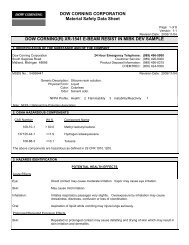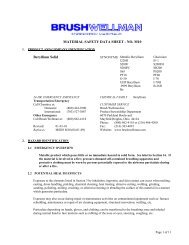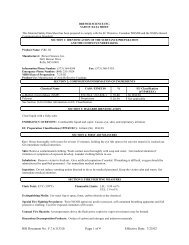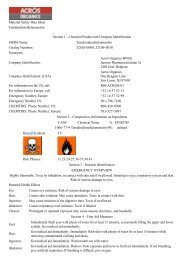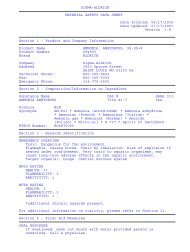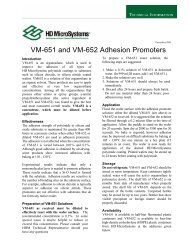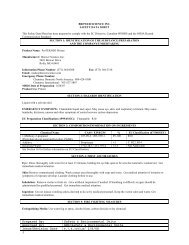(dimethylamino) hafnium - Stanford Nanofabrication Facility
(dimethylamino) hafnium - Stanford Nanofabrication Facility
(dimethylamino) hafnium - Stanford Nanofabrication Facility
Create successful ePaper yourself
Turn your PDF publications into a flip-book with our unique Google optimized e-Paper software.
Product: Tetrakis(<strong>dimethylamino</strong>)<strong>hafnium</strong> P-6280-B Date: February 2005<br />
THRESHOLD LIMIT VALUE: TLV-TWA, 0.5 mg/m 3 (ACGIH, 2004). TLV-TWAs should be used<br />
as a guide in the control of health hazards and not as fine lines between safe and dangerous<br />
concentrations.<br />
EFFECTS OF A SINGLE (ACUTE) OVEREXPOSURE:<br />
INHALATION–Liquid or vapor may irritate the respiratory tract to an unknown degree, but severe<br />
respiratory irritation may result in respiratory inflammation, edema, and chemical pneumonitis. May<br />
cause coughing, wheezing, laryngitis, shortness of breath, headache, nausea, and vomiting. Reaction<br />
with moisture produces <strong>hafnium</strong> oxide powder and may generate potentially harmful organic vapors.<br />
SKIN CONTACT–The liquid and vapor may irritate the skin.<br />
SWALLOWING–Hafnium compounds may be fatal if ingested. Can cause liver damage. Ingestion<br />
may be extremely irritating to the mouth and throat and cause perforation of esophagus and stomach.<br />
May cause gastrointestinal distress, nausea, vomiting, and headache.<br />
EYE CONTACT–Liquid or vapor may result in permanent damage and loss of vision, depending on<br />
severity of exposure.<br />
EFFECTS OF REPEATED (CHRONIC) OVEREXPOSURE: Repeated or prolonged exposure of the<br />
skin may cause dermatitis (inflammation of the skin). With prolonged or repeated exposure, harmful<br />
amounts may be absorbed through the skin.<br />
OTHER EFFECTS OF OVEREXPOSURE: Zirconium impurity may cause allergic rash.<br />
MEDICAL CONDITIONS AGGRAVATED BY OVEREXPOSURE: The skin irritating properties<br />
of tetrakis(<strong>dimethylamino</strong>)<strong>hafnium</strong> may aggravate an existing dermatitis. Respiratory irritation may<br />
aggravate an existing asthma or other upper respiratory or pulmonary disease. Ingestion may aggravate<br />
digestive tract ailments.<br />
SIGNIFICANT LABORATORY DATA WITH POSSIBLE RELEVANCE TO HUMAN HEALTH<br />
HAZARD EVALUATION: None known.<br />
CARCINOGENICITY: Tetrakis(<strong>dimethylamino</strong>)<strong>hafnium</strong> is not listed by NTP, OSHA, or IARC.<br />
4. First Aid Measures<br />
INHALATION: Immediately remove to fresh air. If not breathing, give artificial respiration. If<br />
breathing is difficult, qualified personnel may give oxygen. Closely monitor the victim for wheezing,<br />
coughing, or pain. Call a physician.<br />
SKIN CONTACT: Remove contaminated clothing and shoes, and wash exposed areas with soap and<br />
plenty of water. Wash contaminated clothing prior to reuse; discard shoes. Seek medical attention if<br />
discomfort persists.<br />
SWALLOWING: Get immediate medical attention. If victim is conscious, wash out mouth with water.<br />
Keep victim calm. Do not induce vomiting unless directed to do so by medical personnel.<br />
EYE CONTACT: Immediately flush eyes thoroughly with water for at least 15 minutes. Hold the<br />
eyelids open and away from the eyeballs to ensure that all surfaces are flushed thoroughly. See a<br />
physician, preferably an ophthalmologist, immediately.<br />
NOTES TO PHYSICIAN: There is no specific antidote. Treatment of overexposure should be directed<br />
at the control of symptoms and the clinical condition of the patient.<br />
Exposure to zirconium, present as an impurity at



